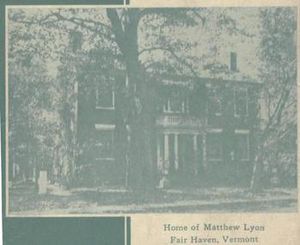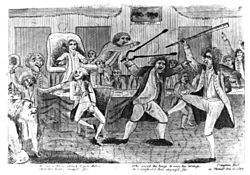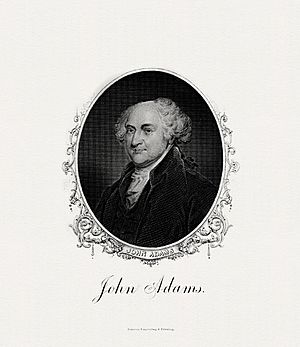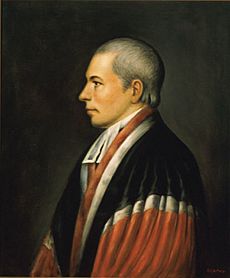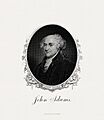Matthew Lyon facts for kids
Quick facts for kids
Matthew Lyon
|
|
|---|---|
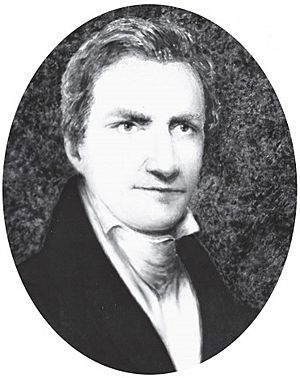
Black-and-white close-up of portrait on display at Vermont State House
|
|
| Member of the U.S. House of Representatives from Kentucky's 1st district |
|
| In office March 4, 1803 – March 3, 1811 |
|
| Preceded by | Thomas T. Davis |
| Succeeded by | Anthony New |
| Member of the U.S. House of Representatives from Vermont's 1st district |
|
| In office March 4, 1797 – March 3, 1801 |
|
| Preceded by | Israel Smith |
| Succeeded by | Israel Smith |
| Personal details | |
| Born | July 14, 1749 County Wicklow, Kingdom of Ireland |
| Died | August 1, 1822 (aged 73) Spadra Bluff, Arkansas, U.S. |
| Political party | Democratic-Republican |
| Spouses | Mary Horsford and Beulah M. Chittenden |
| Children | 12, including Chittenden Lyon |
| Profession | Printer Newspaper publisher Businessman Farmer |
Matthew Lyon (born July 14, 1749 – died August 1, 1822) was an American politician who was born in Ireland. He worked as a printer, farmer, and soldier. He is famous for serving as a U.S. Representative for two different states: Vermont and Kentucky.
Lyon represented Vermont in Congress from 1797 to 1801. Later, he represented Kentucky from 1803 to 1811. His time in Congress was quite eventful. He even had a physical fight with another Congressman. He was also put in jail for breaking the Sedition Act, a law that limited free speech. Even while in jail, he was re-elected to Congress!
Lyon's trial and time in prison made him a hero for free speech. Many people in the new Democratic-Republican Party saw him as someone who stood up for important rights.
Contents
Early Life and Military Service
Matthew Lyon was born in County Wicklow, Ireland, and went to school in Dublin. In 1764, he moved to Connecticut in America. He worked for a farmer and merchant to pay off his travel debt. He continued to learn by studying on his own whenever he could. By 1768, he had saved enough money to become a free man.
Moving to Vermont
While living in Connecticut, Lyon met many people who would later become the first white settlers in Vermont. In 1774, Lyon moved to Wallingford, Vermont. There, he started a farm and helped organize a group of local soldiers called a militia.
Revolutionary War Hero
During the American Revolutionary War, Lyon first served under General Horatio Gates in New York and Vermont. Some of his political rivals later claimed he was removed from duty for being a coward. However, Lyon said he and his men were just guarding wheat fields and wanted to be in more important battles. He asked to join a different regiment. His actions were later supported by other military leaders.
Lyon then joined Colonel Seth Warner's regiment as a paymaster, with the rank of captain. He fought in important battles like the Battle of Bennington. After leaving Warner's Regiment, Lyon continued to help the American cause. He served on Vermont's Council of Safety, became a captain (and later a colonel) in the militia, and helped the governor and treasurer of Vermont.
Political Career in Vermont
From 1779 to 1783, Lyon served as a member of the Vermont House of Representatives for Arlington. In 1783, he founded the town of Fair Haven, Vermont. He continued to serve in the state House of Representatives for Fair Haven until 1796.
Starting Businesses
In Fair Haven, Lyon built and ran several businesses. These included mills for grinding grain, cutting wood, and making paper. He also had an iron foundry. In 1793, he started a printing office and published a newspaper called Farmers' Library. Even though his son was the official owner, Matthew Lyon managed the paper and wrote much of its content. This newspaper was later renamed the Fair Haven Gazette. In 1794, Lyon sold his printing equipment, which was then used to start the Rutland Herald newspaper.
Serving in Congress
Lyon tried to get elected to Congress a few times before he succeeded. He finally won election as a Democratic-Republican to the Fifth and Sixth Congresses. He served from March 4, 1797, to March 3, 1801.
The Famous Fight
Matthew Lyon was one of the first members of Congress to be investigated for breaking House rules. This happened after he spit in the face of another Congressman, Roger Griswold. Griswold was also investigated for attacking Lyon in return.
On January 30, 1798, the House was discussing whether to remove a member from office. Griswold, a Federalist, was trying to get Lyon's attention, but Lyon, a Democratic-Republican, was ignoring him. Griswold got angry and insulted Lyon. Lyon then spit tobacco juice on Griswold. This earned Lyon the nickname "The Spitting Lyon."
Lyon later apologized to the House. However, Griswold was not satisfied. On February 15, 1798, Griswold attacked Lyon with a wooden cane right on the House floor. Lyon defended himself with fire tongs until other Congressmen stopped the fight. A committee suggested punishing both men, but the House decided not to. The issue was resolved when both Lyon and Griswold promised to behave.
Speaking Out and Going to Jail
Matthew Lyon also has the unique honor of being the only person elected to Congress while in jail. On October 10, 1798, he was found guilty of breaking the Alien and Sedition Acts. These laws made it illegal to write or say bad things about the American government, Congress, or the President. Lyon was the first person tried under these acts. He had published articles criticizing Federalist President John Adams.
Lyon had started his own newspaper, The Scourge Of Aristocracy and Repository of Important Political Truth. He did this after another newspaper refused to publish his writings. In one article, Lyon criticized President Adams. Before the Sedition Acts were passed, Lyon had also written a letter calling the President "bullying" and the Senate's actions "stupid."
After the Sedition Acts became law, Federalists pushed for this letter to be published, adding more charges against Lyon. Lyon argued that these laws were against the First Amendment and the Constitution. However, his defense was not allowed.
Lyon was sentenced to four months in a small jail cell in Vergennes. He also had to pay a $1,000 fine and court costs. While he was in jail, Lyon won re-election to Congress by a large number of votes. When he was released, he told a crowd of supporters, "I am on my way to Philadelphia!"
Years later, in 1840, Congress passed a law to give back the money Lyon had paid for his fine and other costs, plus interest.
A Key Vote in the Election of 1800
In the election of 1800, there was a tie in electoral votes between Thomas Jefferson and Aaron Burr. Because of this, the vote went to the House of Representatives. Many Federalists preferred Burr over Jefferson.
House members voted by state. To win, a candidate needed a majority of nine states. For the first 35 votes, Jefferson had eight states, and Burr had six. Two states, including Vermont, were tied among their House members, so they had "no result." In Vermont, Lewis R. Morris voted for Burr, and Lyon voted for Jefferson.
On the 36th vote, some Federalists decided to let Jefferson win. They either cast blank ballots or left the House chamber. Morris was one of them. Because Morris was absent, Lyon's vote for Jefferson counted for Vermont. Vermont became one of two states to switch to Jefferson, helping him win with 10 states on the final vote. Lyon's vote was very important in Jefferson's victory.
Later Life and Career
Moving to Kentucky
By 1801, Lyon had moved to Kentucky, settling in Eddyville. He started a paper mill and a distillery. He also got into boat building. The Department of War hired him to build gunboats for the War of 1812. When the war ended, the government did not pay him for his work, and Lyon faced financial difficulties. He worked hard to recover and by 1818, he had paid off his debts and was doing well again.
Return to Congress
In 1802, he became a member of the Kentucky House of Representatives. He was then elected to the Eighth and three following Congresses, serving from March 4, 1803, to March 3, 1811. He tried to be re-elected in 1810 but was not successful.
Final Years in Arkansas
After getting his finances back in order, Lyon asked for a government job that would provide a steady salary. In 1820, President James Monroe, a friend of Lyon's, appointed him as a U.S. agent to the Cherokee Nation in the Arkansas Territory. He tried one more time to serve in Washington, D.C., by running for the delegate seat in Congress for Arkansas Territory. He lost the election by a small margin and challenged the results, but he could not gather enough proof to support his claim. He then withdrew his challenge.
Death and Burial
Matthew Lyon died in Spadra Bluff, Arkansas, on August 1, 1822. He was first buried there, but in 1833, his body was moved to Eddyville Cemetery in Kentucky.
Family Life
Matthew Lyon was married twice. His first wife was Mary Horsford, whom he married in 1772. She passed away in 1782. His second marriage was to Beulah M. Chittenden in 1784. She was the daughter of Thomas Chittenden, who was a governor of Vermont.
Lyon had 12 children. His son James (1776–1824) was a newspaper editor and publisher. Another son, Chittenden Lyon (1787–1842), also served in the U.S. House of Representatives for Kentucky. His grandson, Hylan B. Lyon, became a Confederate General.
His daughters, Anne and Pamelia, married pioneers and politicians in Illinois. Matthew Lyon was also the great-grandfather of William Peters Hepburn, who represented Iowa in Congress. The famous opera singer Sherrill Milnes is also one of Lyon's descendants.
Legacy
In 2006, the post office in Fair Haven, Vermont, was named in honor of Matthew Lyon. In 2018, a music album called Spit'n Lyon was released, based on his life story.
A World War II ship, the SS Matthew Lyon, was also named after him.
Images for kids


